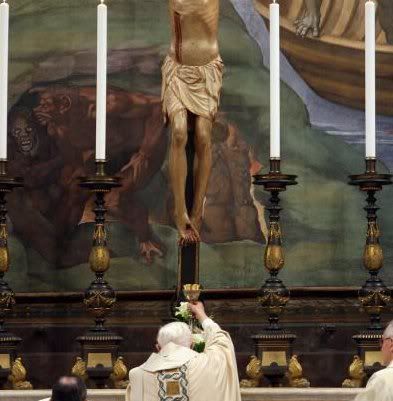I've been thinking a lot lately about hope. If you've been following my blog entries for the last couple of months, you may have noticed that I've been experiencing a rather rocky year, especially since the beginning of June. Plans have changed, sin has weighed me down, the struggles of the spiritual life on top of everything else has left me feeling burnt-out and exhausted. And through it all there have been times where I've just wanted to throw up my hands and say: "Forget about it! It's too hard to be a Christian any way!" Fortunately, God has kept such lines of thought from maturing into anything truly dangerous. He's always taken the time through it all to remind me that with Him - if I let Him do what He wishes - all things are possible.
I was deeply moved the other day reading an article about the cause for cononization of a certain French criminal in the
Our Sunday Visitor. It was a rather controversial article, and indeed the man it is about is a very controversial figure. The article I speak of had dubbed this man the "saintly killer."

Jacques Fesch was born a Catholic, and even a devout one through his youth, but before long his family was broken to pieces over his not-so-devout father's adulterous escapades. Dissilusioned with his faith, Jacques quickly became an incorrigible juvenile delinquint. He was expelled from his school, and after getting his girlfriend, Pierrette, pregnant, married her at the young age of 21. He had a chance at a more dignified life, of cleaning up his act, when he was offered a position at his father's bank, but he soon found himself leaving that job, and eventually his wife and daughter, Veronique, to pursue a somewhat wild dream to sail away to the South Pacific. His parents would have not part in it, refusing to pay for a boat, leaving Jacques in desperate need of money. Turning to theft, he tried to rob a money changer, but couldn't pull off the heist. As he fled the scene, a police officer by the name of Jean Vergne tried to arrest him, but Jacques did the unthinkable. He pulled out his revolver and shot Vergne three times, killing him. Jacques was soon caught by the angry mob the rose up in response to the officer's shooting, was quickly tried, then sentenced to death.
So far you might be thinking "has the Church lost her mind? This isn't a saint! This guys a cold blodded killer!" And if this were the end of this man's story, I would agree with - and so would the Church for that matter. But there's more to it. After spending a year on death row openly mocking the Catholic faith of his lawyer, something happened very suddenly an unexpectedly on February night in 1955. Recorded in his journal, and quoted from the OSV article, his recounting of his conversion experience went like this:
" 'I was in bed, eyes open, relly suffering for the first time. It was then a cry burst from my breast, and appeal for help. Instantly, like a violent wind which passes over without anyone knowing where it comes from, the spirit of the Lord seized me by the throat. I had an impression of infinite power and kindness and, from that moment onward, I believed with an unshakeable conviction that has never left me.' "
And from that moment onward, Jacques Fesch lived and died in a state of grace. He even reconciled with his wife and daughter the night before he died. What makes this story so powerful is that God would not reject what society counts as a lost cause, an absolute evil, the scum of the earth. No matter how sick with sin, diseased in our hearts we may be, there is hope in Christ! There is great opposition to the canonization of this man, as you may be able to imagine, because of the potential mixed message it may send to society. But I think that the Church has never sent a more clear message about the great saving power of our God. We're in a world today that saps hope from every quarter. We see the media heaping upon our young women impossible demands about how they should look and act, leaving them feeling hopelessly inadequate, and somehow worthless; we see relativism and secularism draining us of our moral and spiritual convictions, reducing them to mere "opinions," instead of the absolute truths that they are; and we see desperate young people, confused, dissillusioned with life, reaching out for something, but finding only ashes in the vain, passing pleasures of this life... and how many of them end their lives so soon...?
That's why the Church needs a saint like Jacques Fesch, to show us that there is never such a thing as vain hope, so long as our hope is in Christ. He has won for us all the grace necessary to melt the heart of even the most hardened sinner, if only he (or she) opens that door in the tiniest bit. Let us pray for the cause of Jacques Fesch, and let us pray for a great abundance of the virtue of hope in our world. It's never too late to turn back to Him. Let us pray for those who seem lost in darkness, with little hope of finding the light again!







